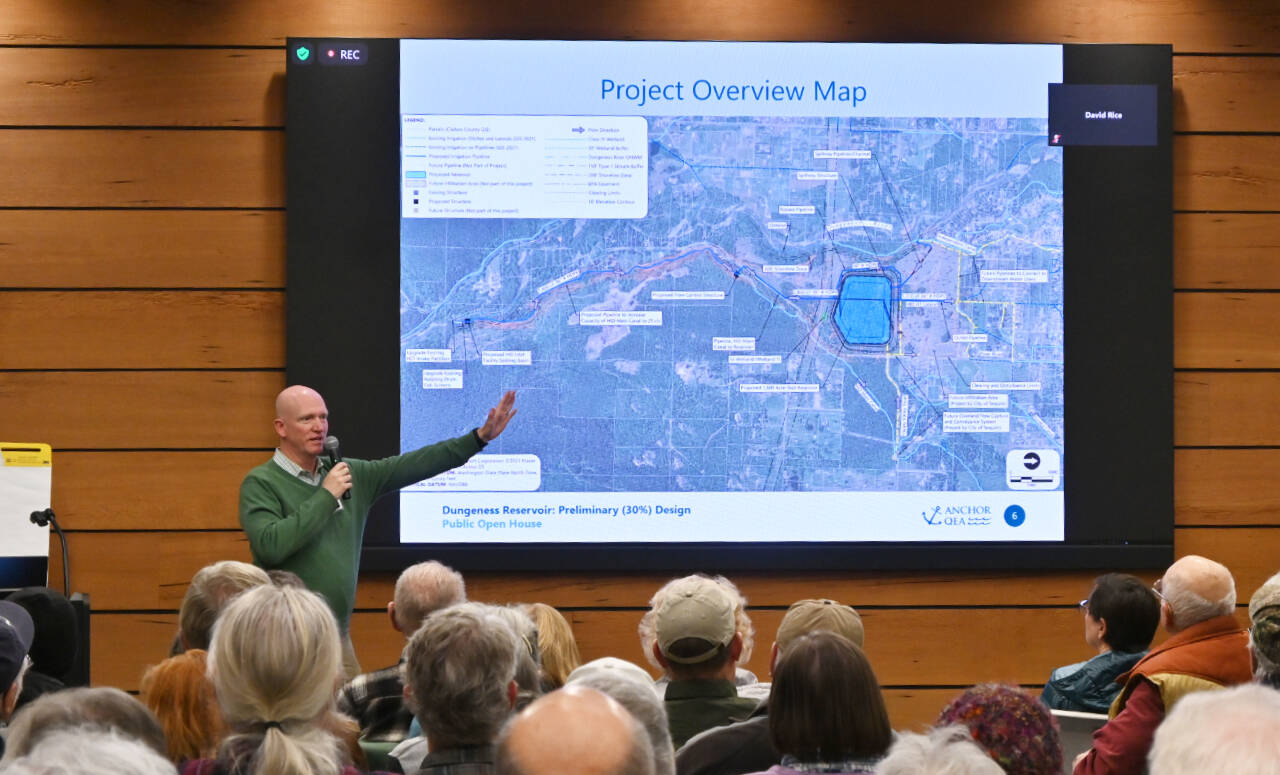SEQUIM — Partners and advocates of a proposed reservoir off Dungeness River intended to help salmon, provide irrigation water and create a new county park detailed initial designs and answered concerns about the project from a standing-room-only crowd.
Proponents of the Dungeness Off-Channel Reservoir, a project about a decade in the planning, described last week what’s called a 30 percent design at the Dungeness River Nature Center, with about 135 people in attendance.
The 42-acre reservoir — targeted for land just east of the river near River Road, property currently owned by the state Department of Natural Resources — would take water from the Dungeness River during the winter and spring months and disperse it in the late summer months, when the river flows are lowest and irrigation water demand at its highest.
“I think we all understand there are a lot of demands on the Dungeness River, figuring out balance of salmon and irrigation water,” Clallam County commissioner Mark Ozias said Tuesday.
“This reservoir is a piece of that puzzle.”
Supporters of the project say it will improve salmon restoration, provide irrigation water at key times for local farmers, protect city stormwater infrastructure and establish a 400-acre county park.
“We really struggle over the years with low flows in the river,” Ben Smith, president of the Dungeness Water Users Association, told the crowd.
“We feel this is the next step to having consistent water supply, even in the dry years” and not affect the salmon, he said.
“Even internally, there are a lot of details to figure out,” Smith said.
Two residents of Kane Lane, which would be near the proposed reservoir, expressed concerns about the height of the earthen embankment, which now is set to rise 30 feet above the ground.
“A lot of people assume it’s going to be a ground-level lake,” said Paul Moore.
“I’m not trying to stand in the way of the project,” he said, but he wants to see a design that reduces the earthen structure holding in water reduced from 30-plus feet to something closer to 10 feet.
David Jensen, whose home would be about 900 feet from the reservoir, fears the effects of an earthquake.
“We’re due for that earthquake,” Jensen said, referring to the Cascadia Subduction Zone, which experts have said is not a question of if it will happen but when.
“I’m going to be a graveyard, and all those people in Dungeness Meadows, if all of that lets go,” he said.
A reservoir reduced in size and less of a threat to neighbors would be better, Jensen said.
“I’m not against the project — it’s the design that’s totally faulty,” he said. “Everything was positive [at that meeting], and I know better.”
Carol Creasey, Clallam County project manager and hydrogeologist, took a few questions attendees submitted prior to the presentation, before turning the program over to an open house-style meeting, with representatives addressing project components — preliminary design, agriculture/irrigation viability, aquifer recharge, permitting/safety/operations, and streamflow restoration and salmon — at five separate stations.
Creasey said comments and questions would be collected, and a frequently asked questions (FAQ) page would be posted on the project web page (see clallamcountywa.gov/188/Dungeness-Off-Channel-Reservoir).
Creasey also said there is still plenty of funding needed before the Dungeness Off-Channel Reservoir becomes a reality. With about $12.8 million secured, the project of construction alone is about $36 million, she said.
The Dungeness Off-Channel Reservoir project was created more than 10 years ago by the Dungeness Reservoir Work Group — a coalition of partners including Clallam County, City of Sequim, Jamestown S’Klallam Tribe, Clallam Conservation District, Ecology, state Department of Fish and Wildlife, Washington Water Trust and the Dungeness Water Users Association, a collective of seven irrigation districts and companies.
In low snowpack years, there is not enough flow in the river to support salmon and also meet out-of-stream water needs, they said. Their solution is an off-channel reservoir to store water during winter and spring when flows are plentiful, saving this water for later in the year when river flow is low.
Design of the reservoir could be completed by 2023, but it would take another two years to construct the project, Creasey said Tuesday.
“We have quite a ways to go,” she said.
Those interested can provide comments at the web page above, by email (web_reservoir@clallamcountywa.gov) or by contacting Creasey (carol.creasey@clallamcountywa.gov).
Sign up for project update emails at code tinyurl.com/38krbzsy.
Initial designs
Dave Rice, a principal water resources engineer with Anchor QEA — the lead engineering company for the reservoir project — said this isn’t the first time the idea has been floated to capture and disperse river water during the drier months of the year.
But holding water below ground level meant pumping it out, and that was too expensive a proposition for some, Rice said.
Instead, the current design would use gravity and irrigation pipes already in use to fill the reservoir of about 1,600 acre-feet of water.
The reservoir would fill up through June, then be drained out in August through mid-September, project managers said.
Because the reservoir’s water will flow in and out of the reservoir using gravity rather than pumps, that necessitates a certain volume of water to be above ground level for part of the year, said Bob Montgomery, also a principal water resources engineer with Anchor QEA.
The reservoir would have to meet what Rice called a “very stringent” set of requirements from the state Department of Ecology’s Dam Safety Office, the entity providing oversight for projects like the Dungeness Off-Channel Reservoir, to protect lives and property downstream.
“[Safety] is always at the forefront of our minds,” Rice said.
________
Michael Dashiell is the editor of the Sequim Gazette of the Olympic Peninsula News Group, which also is composed of other Sound Publishing newspapers Peninsula Daily News and Forks Forum. Reach him at editor@sequimgazette.com.

